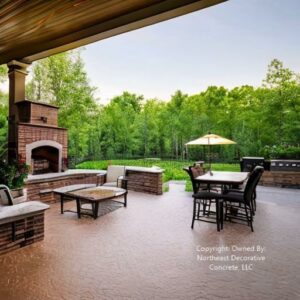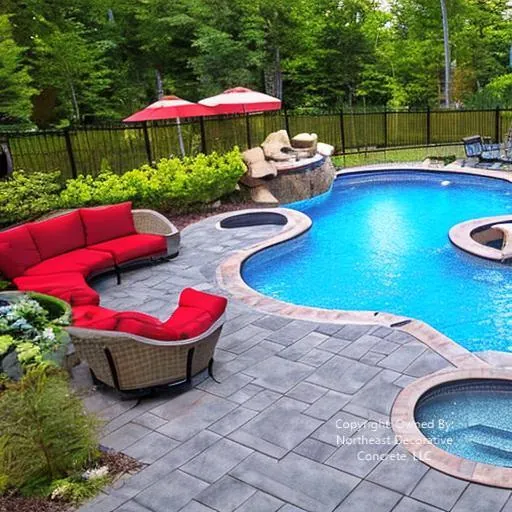
Proper Concrete Sealer Sealing Stamped Concrete Temperatures
Sealers protect decorative concrete surfaces. They soak into the surface and create a strong bond. However, the sealant and the concrete only react within a specific proper temperature range. Sealants need the right conditions to work.
| Sealer Type | Low Temp Effect | High Temp Effect | Ideal Temp Range |
|---|---|---|---|
| Water-based | Slows curing, weakens film | Flash drying, whitening | 50-80°F / 10-27°C |
| Solvent-based | Extends curing time | Speeds curing, trapped bubbles | 50-90°F / 10-32.22°C |
| Epoxy | Slows curing reaction | Speeds curing reaction | 60-85°F / 15.56-29.4°C |
Manufacturers recommend applying most sealers when the air and concrete are 50°F(10°C) to 90°F(32.22°C). If it’s colder or hotter, you risk issues:
-
Flaking or peeling
-
Blotchiness
-
Weak protection that wears away quickly
-
Bubbling
-
“Cobwebbing” – those wiggly strands that look like spider webs
Check the air and concrete temps with an infrared thermometer before starting to avoid a mess. (A surface thermometer will be the most accurate for concrete.) Schedule sealing for a mild morning or evening if temps will spike later. Never apply clear surface finishes below 40°F or over 90°F.
Cold Temperature Troubles
What exactly happens when it’s brisk outside? The chemical reaction in the sealant slows way down. It needs more time to soak in and dry before you can walk on it. Wait too long between coating layers, and they won’t bond well.
If temps dip below the sealer’s “minimum film forming temperature” (check the product specs), it won’t dry. You’re left with a slimy, sticky, unprotected mess. No good!
Many solvent-based layers can still be applied down to 40°F. But if things dip below freezing that night, don’t risk it! The acrylic sealer could freeze and fail altogether.
Beating the Heat
Sealers tend to dry too quickly on the surface on hot, sunny days. The solvent evaporates before the resin can penetrate. This leaves those dreaded “bubbles” behind – and very little protection.
Blisters and bubbling can also happen. This occurs when the sealer dries fast, trapping solvent underneath. Then pop – ugly bubbles that ruin the nice, smooth finish!
The hotter things get, the faster you’ll have to work. And the thinner each layer should be to prevent issues. Spray applications are best for keeping things quick and even in heat.

More Than Just Temps
Temperature isn’t the only factor that affects sealing stamped concrete applications. Humidity and dew point matter, too.
-
Humidity should stay under 70% and be falling for proper seal curing. It’s too humid, and drying happens way slower.
-
The dew point is the temperature where condensation forms. If it’s too close to the current temp, water will make a mess of your sealing efforts.
Checking weather reports in advance lets you pick that perfect dry, mild day for sealing. Avoid early morning dew, late-day showers, or surprise cold snaps.
Prepping for Tricky Stamped Concrete Temps
Can’t reschedule based on weather? With a few adjustments, you can still seal successfully even when temps aren’t ideal:
Cooler Weather Tips
-
Warm the concrete with space heaters before applying sealer
-
Use solvent-based instead of water-based sealants
-
Apply thinner layers so less sealer has to cure
-
Allow longer drying times between coats
-
Use a sealer with a lower minimum film-forming temp
Hot Weather Tips
-
Prep and seal early or late in the day
-
Use evaporative retardant to slow-drying
-
Mist water between coverings if the concrete is very hot
-
Apply thinner layers
-
Switch to a faster-drying sealer formula.
-
Use sprayers for quick, even application.
Watching the Forecast
-
Attention to the weather makes a big difference for seamless, long-lasting sealer performance. Apps even make it easy to monitor conditions right from your smartphone.
-
Before you seal, don’t just step outside and guess the temperature. Check an accurate thermometer instead, along with the humidity percentage. Glance at the weather radar to avoid surprise showers.
-
If the forecast looks questionable, consider rescheduling. It might feel like a hassle, but it beats re-doing a sealing job!
-
With planning and adjustments, you can seal stamped concrete well. Even when the weather throws a curve ball. Check conditions closely. Change methods if needed. Don’t hesitate to postpone. Taking your time ensures the sealer bonds tightly for many years of beauty ahead.

Decorative Concrete Common Sealer Issues in Cool Weather
Crisp fall air signals changing leaves, cozy sweaters – and tricky concrete sealing weather! You may be tempted to finish your to-do list before winter. But, cool temps come with unique challenges.
To help your efforts go smoothly, here are the most common sealer issues when the mercury dips:
Longer Dry Times
One of the most significant effects of cooler weather is that sealers take longer to dry and cure. Where you may wait just an hour between layers in summer, drying times can stretch to 8 hours or more when temps drop. Be sure to allow for enough dry time. Base it on product guidelines and the weather. Rushing between layers when sealers are still tacky causes poor adhesion. It also leads to later flaking.
Reduced Penetration
For the best protection, sealers need to soak well into concrete pores. But that penetration ability drops as temperatures fall. Solvents thicken in cool weather, making it harder for them to carry resins deep into the surface. Applying thinner layers can help products soak correctly when they’re brisk. Just be careful to allow adequate dry time between those thinner layers!
Risk of Freezing
This one may seem obvious, but it’s worth repeating: Don’t seal concrete if it may soon freeze! It’s best to wait for 1-2 days. Water-based sealers are especially prone to freezing. But even products that stay solid can crystallize in frigid weather. This leads to a weak bond that later peels and flakes.
Curing Issues
All sealers need a chemical reaction to fully set, dry, and cure. But when mercury dips, those chemical processes slow down. Solvents evaporate more slowly. Resins take longer to bond and harden. If temperatures are extremely low, some sealers may never fully cure. The result is a surface that remains wet, sticky, and unprotected from wear and stains. No good!
Blotchiness
Uneven application technique can leave blotchy spots at any temperature. However, concrete sealers dry slowly in cool weather. So, avoiding lap marks is even trickier. Work quickly and use overlapping application techniques to prevent blotchiness in low temps. Backrolling or redistributing thick areas helps, too. Just ensure that any second passes don’t pull up the tacky sealer.
Hot Weather Sealing Strategies
Don’t let soaring summer temperatures trip up your stamped concrete protective covering! You can still get flawless, long-lasting protection in heat waves. Just take a few easy precautions.
Spray Don’t Roll
Faster application is critical to avoiding “bubbles” and other heat-related sealer issues. Spraying equipment allows you to cover large areas quickly with an even covering. Avoid rolling sealers by hand in hot weather as it can cause overheating.
Seek Shade
Applying is easiest when the surface is under 90°F. So, work early or late when the sun isn’t hitting the concrete. Creating shade with pop-up tents or tarps helps, too.
Mist Between Coats
If the concrete is very hot, a light mist of water between sealer layers helps cool it. Before reapplying, use squeegees or towels to dry any standing puddles.
Mind the Humidity
Humidity impacts drying and curing time. For best results, only apply when humidity is under 70% and falling. If it’s a humid day, hold off for better weather.
Apply Thinner Coats
Using less sealer per coat allows each layer to soak in and dry before adding more. Thin, even layers also help control puddling in high heat.
Consider Retardants
Evaporation retardants are additives that slow drying time in hot weather. This allows more time for sealers to penetrate the concrete before forming a “skin” on top.
You can still get great results despite the heat. You need some clever sealing strategies. Stay flexible as the weather shifts. Adjust methods as needed. Then, your stamped concrete will shine for years of enjoyment!
Our Locations:
Nashua, NH
North Hampton, NH
Concord, NH

